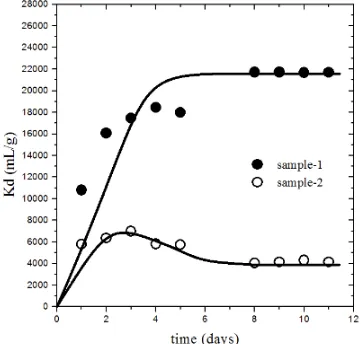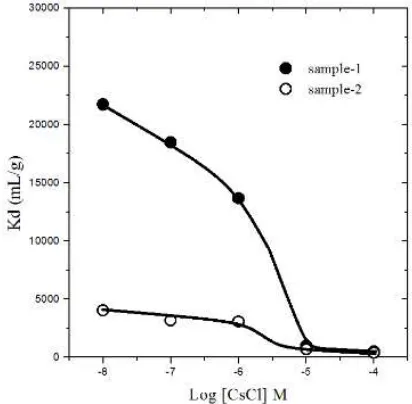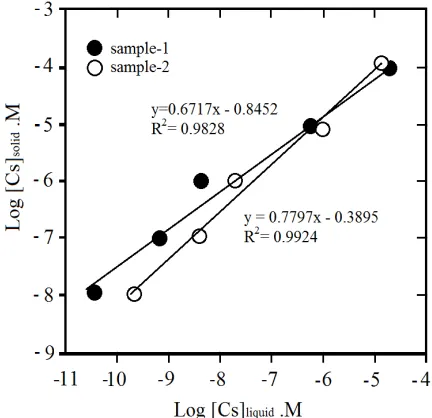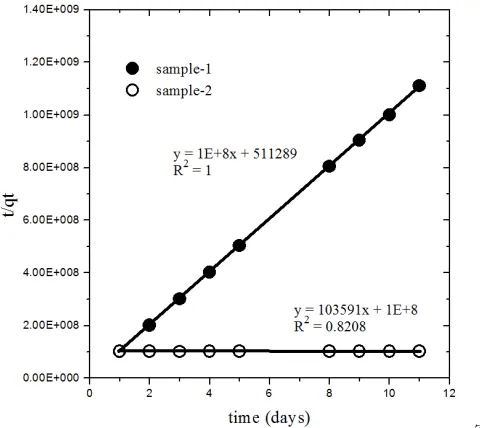Aceh International Journal of Science and Technology
ISSN: 2088-9860
Journal homepage: http://jurnal.unsyiah.ac.id/aijst
Sorption analysis of
137cs on K
arawang’s clay samples
Budi Setiawan1*, Suci Prihastuti2, Setyo S. M oers idik 3
1Center for Radioactive Waste Technology-National Nuclear Energy Agency,PUSPIPTEK Bld 71 3rd Floor, Serpong-Tangerang 15310, Indonesia
2Directorate for Inspection of Nuclear Installation and Material-Nuclear Energy Regulatory Agency, Jl.Gadjahamada No. 8, Jakarta 10120, Indonesia
3Department of Civil Engineering-University of Indonesia, Kampus UI, Depok 16424, Indonesia *Corresponding author email: [email protected]
Received : October 18, 2016 Accepted : December 23, 2016 Online : December 30, 2016
Abstract – The objective of this work is to characterize the specific of distribution coefficient (Kd) values of 137Cs onto Karawang’s clay for radioactive waste disposal facility purpose. Sorption
phenomena was affected by contact time, ionic strength and loaded concentration of CsCl. Experiments were done in a batch method, with initial concentration was 10-8 M CsCl in the
experiments of contact time and ionic strength effects. In the CsCl loading experiment, the concentration was varied from 10-8 to 10-4 M CsCl and 137Cs radioactive solution was used as a
tracer. The solid-liquid ratio is 10-2 g/mL. The results shown that obtained Kd values were 21,714
and 4035 mL/g after contacted for 8 days for Sample-1 and 2, respectively. The presence of K+ and
Na+ ions in solution had reduced the Kd value Cs-137 where the effect of K+ is greater than Na+ on
decreased the value of Kd. The increasing of CsCl concentrations in solution had reduced the value of Kd. In both samples of clay were closely fit to Freundlich isotherm and pseudo-second order kinetic model. The results are very useful as the input of the safety assessment activity of site candidate for radioactive waste disposal facility in the future.
Key words: 137Cs; radioactive waste; clay; sorption; disposal.
Introduction
Radionuclide of 137Cs is one of main product of nuclear fission reaction, and together with 90Sr
and 60Co, 137Cs is the representative of radioactive waste in low-intermediate level (LLW) with its half-life
is 30 years, soluble in water, easy associated with biota in terrestrial and water, mobile in environment and has a similar character with K+ ion (Volcheck et.al., 2011; Bucur et.al, 2011; Mirkhani et.al., 2010). In
general, LLW suggested to be isolated in a near surface facility type disposal facility (IAEA, 2009). Water seepage came from the outside facility can reduce the integrity of waste container, then the water reacts with waste packages containing 137Cs and bring 137Cs out dispersed into environment. Host rock where
the disposal facility placed has functioning as the natural barrier system, controlling the flow of all water and retards the possibility of spread of 137Cs contaminants from the facility into the environment (IAEA,
2014).
Clay rock is suitable applied for radioactive waste disposal site especially on the areas that have a high rainfall such as Jawa Island or in Karawang. The clay rock was chosen due to its low permeability, good sorption and their ion exchange character with metal ions or 137Cs, wide availability mainly in the
Aceh International Journal of Science and Technology
ISSN: 2088-9860
northern part of Jawa Island (Setiawan, 2013; Yildiz et.al., 2011; Sucipta et.al., 2011). Besides the crystalline and granite rocks, clay rock is also the types of rock are used as the host rock for radioactive waste disposal facility such as those in Mol-Belgium and also in Bure-France (ONDRAF/NIRAS and ANDRA, 2015). Clay rock from Karawang Formation is one of the candidates of potential site for radioactive waste disposal in Jawa Island-Indonesia, where as disposal facility site is expected to provide the safety for environment (Sucipta et.al., 2011). Based on these reason, sorption behavior of 137Cs onto natural clay
from Karawang was done, where the contact time, concentration loading, ionic strength, isotherm and kinetic model parameters were applied to estimate the reliability of Karawang Clay planned as the host rock of radioactive waste disposal facility in Indonesia in the future.
The parameter of contact time are intended to acquire the necessary time to reach equilibrium conditions of 137Cs absorbed on clay samples. Ionic strength of the solution which is represented by the
presence of K+ and Na+ ions in the aqueous solution included in the parameters that can affect the 137Cs
sorption onto clay samples (Vejsada et.al., 2005). Effect of concentration of Cs loading on 137Cs sorption
onto clay samples were carried out by contacting clay samples with 137Cs with concentration of CsCl were
varied from 10-8 to 10-4 M (Ugur and Sahan, 2012, Setiawan, 2013).
Sorption Cs onto clay sample was approached by using the distribution coeffisient (Kd) value, where Kd is the ratio of number of metal ions absorbed in solid phase to the number of metal ions remain in solution (Vejsada, 2005; Missana et al, 2008). The objective of this work is to characterize the specific of distribution coefficient (Kd) values of 137Cs onto Karawang’s clay for radioactive waste
disposal facility purpose. This work was done under the umbrella of siting of radioactive waste disposal facilities program in anticipation the introduction of nuclear power plant as one of the energy sources of the future in Indonesia. Previously, the samples from some areas also have been evaluated [Setiawan, 2011a; 2011b; 2012], and in the end of the program will be selected 2-3 locations of the most feasible site for construction of the disposal facilities.
Materials and Methods
Clay samples were taken from Karawang area in West Java-Indonesia with coordinate of E 107 o
24’39.91’’; S 106 o 27’37.36’’ and E 107 o 24’30.49’’; S 106 o 27’25.28’’ for sample-1 and sample-2,
respectively. After clean-up the samples from roots, leaf and gravels, samples were dried in the oven (105oC, 86 hours), air dried, crushed and sieved to obtain the samples with 100 mesh particle size. The
chemical reagent such as CsCl, NaCl and KCl were from E.Merck production, however the radioactive solution of 137Cs as a tracer was from Eckert and Ziegler Isotope Production with sp. Activity is 3.7 MBq/5 mL.
Batch experiment was applied to determine the Kd value. In 20 mL PE vials, 0.1 g of clay samples were contacted with 10 mL of solution containing CsCl and 137Cs as a tracer. The mixture was gently
shaken with a geological roller machine for 12 days. The initial concentration of CsCl was 10-8 M. The
solid and liquid phases in the vials were separated by using Heraeus Labofuge 400 centrifuge at 2500 rpm and 10 min. The radioactivity in aliquot then are measured with a -spectrometer Canberra multichannel analyzer completed with 20% eff. HPGe detector at 661.6 keV. The typical counting times were at least about 10 min. Quantification of 137Cs absorbed in clay samples determined by using Kd values,
(1)
(2)
(3)
Where [C]0, [C]solid and [C]liquid is the initial concentration of Cs, concentrations of Cs in solid and liquid
phases, At and A0 is the activities of 137Cs in initial and final condition of sorption processes, V and M is
of initial concentration of CsCl were given, whereas the final concentration of Cs was calculated by using eq.(2).
For the experiment of ionic strength effect, the initial concentrations of CsCl was set at 10-8 M in
0.1; 0.5 and 1.0 M of NaCl or KCl. The solution was contacted with 0.1 g of clay samples. And then the procedures of the experiment similar with the above experiment. The Kd could be calculated by using eq. (1).
In the effect of CsCl concentration loading, the initial concentrations of CsCl were varied from 10-8 up to 10-4 M, and then the procedures of the experiment similar with the above experiment.
Results and Discussion Clay sample characteristics
Clay samples were characterized at The Center for forensic lab-Indonesian Police, Jakarta and the Center for integrated lab, Faculty of Science and Technology-State Islamic University Syarif Hidayatullah, Jakarta for XRF and XRD tests. Information of clay content of the samples which was obtained from XRD method analysis have shown that the characteristic peaks of both type of samples in qualitatively have similarity, containing smectite. The results were shown in Table 1.
Table 1. Analytical results of mineral content in Karawang’s soil by using XRD method
No. Minerals Sample-1 Sample-2
Note: +++++ predominantly, ++++ dominant, +++ moderate, ++few, + very few
The mineral structure of smectite is composed of 3 layers, 1 octahedral layer was sandwiched with 2 layers of tetrahedral [Das, 2006]. Between the octahedral and tetrahedral layers there are monovalent as well as divalent cations such as Na+, K+, Ca2+ and Mg2+ ions were exchangeable ions.
Chemical composition of samples was shown in Table 2. The composition assists estimate samples ability to absorb the dissolved radionuclide, especially when associated with ion exchange mechanisms between the metal ions. The number of cation absorbed correspond with the cation exchange capacity of the samples [Missana, et.al., 2008].
Effect of contact time
A typical result of 137Cs sorption into clay samples as a function of contact time was
shown in Figure 1. In the early of 137Cs contacting, the sorption rate of samples was fast up to 8
days. After 8 days contact, the increasing of Kd value was slower and then relatively constant. The number of active site in the samples becomes saturated with 137Cs, and equilibrium state of 137Cs sorption was reached [Lujaniene, et.al., 2006]. The obtained Kd values were 21714 and 4035
mL/g in sample-1 and sample-2, respectively. The difference of Kd value of both samples is predicted to be due to differences of chemical contents in the chemical composition of the sample.
Figure 1. Sorption of 137Cs as a function of time
Effect of ionic strength
Ionic strength of solution was represented by Na+ and K+ ions, in the groundwater both ions have enough high concentration so that is expected to affect the ability of sample absorbance to 137Cs. Increasing in Na+ and K+ in the solution may block the interaction between 137Cs with
samples, and they can reduce the number of 137Cs that was absorbed into the samples as shown in
Figure 2. This may be explained by consideration of the structure of the electrical double layer around the samples [Rao, Choppin, 1995]. In the surrounding of samples, a part of the surface charge is neutralized by Na+ or K+ ions attracted by ion exchange mechanism with the sample.
Therefore the concentration of Cs+ in the close vicinity of sample is controlled by the competition
between Na+ or K+ and 137Cs+ to this zone. In other words, some part of formation metal
ions-clay sample proceeds via an ion exchange between Na+ or K+ and the 137Cs+. With similar chemical
properties between Cs+ and K+ ions in solution causes the Kd values of 137Cs smaller than when
Figure 2. Effect of ionic strength in 137Cs sorption, in sample-1 (left) and sample-2 (right).
Effect of Cs concentrations loading
Figure 3 showed that Kd values decreased with increasing of Cs concentration loading in solution. Significantly the Kd values decreased, it was predicted as the limitation of samples in their exchange capacity to 137Cs+. Increasing the concentrations of Cs+ ion in solution was not
comparable to the sorption capacity of samples, and the Kd values goes to their new saturated level [Staunton and Roubaud, 1997; Vejsada, et.al., 2005].
Figure 3. Effect of Cs concentration loading in 137Cs sorption
Isotherm sorption
Sorption isotherm illustrated the number of metal ion distributed among solid and liquid phases when the sorption processes reached equilibrium states. For that purpose, the mixture of solution and samples were contacted in 8 days with initial Cs concentrations were varied. Sorption of 137Cs in both samples of clay were approached with Freundlich isotherm with its equation form as
[C]s = k[C]n (4)
Where [C]s and [C]l are the number of Cs absorbed on the solid phase at equilibrium and remains in
solution, k is a constant that is related to sorption capacity and n is an empirical parameter that varies with the degree of heterogeneity of the samples. Slope of n is obtained from the interception of plotting of log[C]s and log[C]s [Yildiz, et.al., 2011]. If the eq. (4) is wrote in a logarithmic model, the equation
changed as,
Log[C]s = logk + n log[C]l (5)
In Figure 4 showed that regression determination of linear isotherm was obtained better for sample-2 than for sample-1, and R2 of sample-1 and 2 were 0.9828 and 0.9924, respectively. The n values of the
experiment were 0.671 and 0.779 for sample-1 and sample-2, and a similar result was found in other experiment where n=0.8285 on the sorption of Cs on bentonite samples [Yildiz, et.al., 2011]. Sorption capacity (k) of sample-1 and sample-2 were 0.143 and 0.408. Approximation in a linear model could be used as indication in the isotherm sorption of both samples, and the values obtained from linear isotherm are valid only for the concentration range used in the experiment. For the higher concentrations used could overestimate the 137Cs sorption and errors may occur when concentration range were extended over
the concentration used. Since the both samples contain smectite, the sorption of 137Cs could occur on ion
exchange reactions or in a highly selective sites of fried edge site (FES) [Bucur, et.al., 2011].
Figure 4. Freundlich sorption isotherm of 137Cs
Kinetic model of sorption
Kinetics of sorption explained the existence of sorption process of absorbate by the absorbent as a function of time. The number of substances that absorbed in a weight of absorbent depends on the concentration of absorbate and the number of absorbent’s site vacant.
The results of kinetic model of the sorption processes on the sample w ere shown in Figure 5. The kinetic model of the experiment result followed the pseudo-second order. The model has been developed by Ho and McKay based on complex reaction occurred in the surface between absorbate and absorbent, and by assuming that sorption capacity of solid phases proportion with the number of active site on the absorbent. Constant of sorption rate determined by the following equation,
where k2 is kinetic constant, qt and qe are the number of absorbate absorbed at time t and at equilibrium
condition. The result of integration and using of boundary condition qt=0 at t=0 and qt=qt at t=t gives the result,
(7)
and the eq.(6) could be linear as follow,
(8)
plotting of t/qt versus t is a linear curve with slope 1/qe and the intercept is 1/k.qe2 [Ho and McKay, 1999;
Zaker, et.al., 2013].
z Figure 5. Kinetics model in pseudo-second order
From the Figure 5, sorption of 137Cs probable followed pseudo-second order of kinetic model with
relation coefficient values R2=1 and 0.820. Sorption constant rate (k2) of sample-1 and sample-2
were 1.9x1011 and 1.073 g.mol-1.day-1 with the number of 137Cs absorbed on clay samples per-unit
weight at equilibrium were 1x10-8 and 9.6x10-5 mol/g, respectively. The k-value is a parameter of
kinetics sorption indicates the pace of sorption processes. The larger of k-value, the sorption processes also faster [Sekewael, et.al., 2013]. Other researcher also indicated their sorption mechanism followed pseudo-second order model for Cs sorption behavior on humic acid with initial concentration lower [Celebi, et.al., 2009], and sorption of Cs on cement mortar [Volchek, et.al., 2011]. Specific sorption characteristics are indispensable, and the results will be very useful as the input of the safety assessment activity of the site candidate for radioactive waste disposal facility in the future.
Conclusion
Smectite mineral dominated in clay from Karawang, and 8 days contact time was needed to reach the saturation states of 137Cs onto clay samples with Kd values were 21714 and 4035 mL/g
137Cs on samples. Sorption model of 137Cs onto both clay samples were approached with
Freundlich isotherm and pseudo-second order kinetic model. The results will be used as the input on safety assessment activity of candidate site for radioactive waste disposal facility in the future.
Acknowledgements
Many thanks to Mr.Suryantoro, Head of Center for Radioactive Waste Technology-BATAN, Mr. I Wayan Bambang Wicaksana, Head of Predisposal and Disposal Technology Division-CRWT, and my colleagues at CRWT-BATAN, Mr. Teddy Sumantry, Ms. Heru Sriwahyuni, Ms. Nurul Efriekaningrum for the assistances, suggestions and the facilities support during the experiments.
References
Anonim. 2009. Classification of radiactive waste, GSG-1. Vienna, Austria
Anonim. 2014. Near surface disposal facilities for radioactive waste, SSG-29. Vienna, Austria.
Bucur, C., Olteanu, M., Dulama, N., & Pavelescu, M. 2011. Cesium sorption/desorption on saligny geologic formations. Journal Romanian Journal of Physic,56(5–6): 769–783.
Celebi, O., Kilikli, A., & Erten, H. N. 2009. Sorption of radioactive cesium and barium ions onto solid humic acid. Journal of Hazardous Material, 168(2-3): 695-703.
Das, B.M. 2006. Principles of Geotechnical Engineering Fifth Edition. Chris Carson, Canada.
Ho, Y. S., and McKay, G. 1999. Pseudo second order model for sorption process. Journal Process Biochemistry, 34: 451-465.
Lujaniene, G., Mazeika, K., Sapolaite, J., Tamulevicius, A., & Motiejunas, S. 2006. Kinetics of cs sorption to clay minerals, Lithuanian Journal of Physic,46: 375-382.
Mirkhani R, Roozitalab MH, Khaleghpanah N, Majdabadi A. 2012. Sorption behavior of cesium and strontium in selected soils of semiarid and arid regions of Iran. Journal of Radioanalytical Nuclear Chemistry, 293: 587-594.
Missana, T., Gutierrez, M. G., & Alonso, U. 2008. Sorption of strontium onto illite/smectite mixed clays. Physics and Chemistry of the Earth, 33: 156–162.
ONDRAF/NIRAS and ANDRA. 2015. Clays in geological disposal systems. The 6th International Conference "Clays in Natural and Engineered Barriers for Radioactive Waste Confinement", March 23-26, Brussels, Belgium.
Rao, L., Choppin, G.R. 1995. Thermodynamic study of the complexation of Neptunium (V) with humic acids, Radiochimica Acta, 69: 87-95.
Sekewael, S., Tehubijuluw, H., & Reawaruw, D. R. 2013. Kinetic studi and isoterm adsorption of pb metal ion ouw village clay activated ammonium nitrate salt. Indonesian Journal of Chemistry, 1(1): 38-46.
Setiawan, B. 2011a. Sorption characterization of radiocesium by host rock of candidate site as reliability indication of radioactive waste disposal site, Proceeding of Environmental Technology and Management Conference 4th ETMC, pp. GC1-1 – GC1-8.
Setiawan, B. 2011b. Penentuan kd radionuklida acuan cs-137 oleh tanah lokasi sp-4 di kawasan nuklir serpong, Jurnal Teknologi Pengelolaan Limbah, 14(2): 43-49.
Ugur, F. A., & Sahan, H. 2012. Sorption behaviour of cesium 137 on kaolinite. Journal Ekoloji 21, 82: 34-40.
Vejsada, J., Hradil, D., Randa, Z., Jeli'nek, E., & Stuli'k, K. 2005. Adsorption of cesium on czech smectite-rich clays: a comparative study. Applied Clay Science,30, 53-66.
Volchek, K., Miah, M. Y., Kuang, W., Demaleki, Z., & Tezel, F. H. 2011. Adsorption of cesium on cement mortar from aqueous solutions. Hazardous Materials, 194: 331-337.
Wati, Zamroni, H., & Martono, H. 2011. Pengolahan limbah rafinat simulasi yang ditimbulkan dari produksi radioisotop molibdenum-99 menggunakan bentonit berpilar dan resin epoksi. Jurnal Teknologi Pengelolaan Limbah , 14(1): 10-22.
Yildiz, B., Erten, H. N., & Kis, M. 2011. The sorption behaviour of cs+ ion on clay minerals and zeolite in
radioactive waste management: sorption kinetics and thermodynamics. Journal of Radioanalytical and Nuclear Chemistry 288: 475-483.




